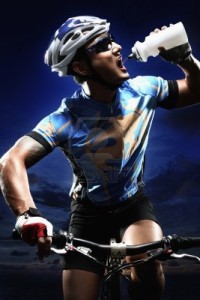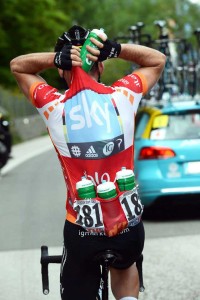Hydration Tips
I know I had a lot of difficulty nailing down my ideal hydration plan, mainly because I didn’t know I had to have one. I drank when I felt thirsty (which inevitably is too late). On top of that I am a heavy sweater and so I never drank early or often enough.
In my early years of cycling I just thought it was due to my fitness, then one day I nailed my hydration plan and was surprised at the huge improvement in performance.
Find your ideal hydration plan, it is well worth your time and effort.
Hypohydration
In layman’s terms hypohydration occurs when you do not have enough water in your body (dehydrated). Core temperatures rise and your blood volume decreases because your cells soak up the available water in the blood stream.
A competition begins for water when there is not enough. Cooling your body and protecting vital organs takes precedence over delivering blood to your muscles, which in turn, results in a serious decline in performance as there is only a finite amount of blood. (and you have just decreased the volume by not drinking enough water).
A loss of only 2% body weight will decrease your performance where as a 3% decrease will decrease your V02max.
Small amounts of water are lost through breathing and keeping your skin moist, where as large amounts are lost through urinating, feces and sweating. During an event or race we are primarily concerned about sweat rates.
What Influences Sweat Rates
- Intensity of exercise – The more intense the exercise the higher the metabolic demand which will increase the heat produced in your body.
- Temperature – A hot day will increase your core body temperature and increase the demand on your body to cool it down.
- Humidity – Humidity will increase your sweat rate as the cooling from evaporation will decrease.
- Wind/Speed – Your body will be cooled by convection more as your speed increases or the wind increases.
- Clothing – Clothing that wicks away sweat will keep you cooler.
Some people have sweat rates as high as 2.5L/hr! The problem with high sweat rates is the fact that your stomach is only able to process between 1L to 1.5L per hour. If you are a heavy sweater it is going to be difficult to replace all of that fluid loss and you may be forced to slow down.
Find Your Fluid Loss Rate
In order to determine your fluid loss rate you need to weigh yourself before exercise (wearing as little as possible… preferably nothing and bladder empty) go and exercise for an hour and then weigh yourself after exercise (wearing/or not wearing, the same amount of clothing).
You have to take into account how much you have drank during the exercise so measure that out as well.
The idea is if you weighed 75kg nude before exercise, drank 500mL of water during the exercise and weighed 74kg after exercise your total fluid loss would be 1.5L/hr. (500mL drank + 1kg less body weight = 1.5L/hr)
Not all weight loss is strictly from fluids; however, it is the majority. Fat loss, muscle loss and liver glycogen loss is very minimal in terms of weight.
It is important to keep in mind that the 1.5L/hr fluid loss rate is estimated for only those conditions that you exercised in (Intensity, temperature, humidity etc.) So if on race day the temperature has increased slightly along with your intensity you can assume you will have a higher fluid loss rate.
Interestingly, it has been discovered that trained endurance athletes will start sweating sooner and have higher sweat rates than sedentary individuals so that they can start the cooling process sooner! (I just tell people I am an “elite athlete” when they ask me why I am sweating so much)
Personalized Hydration Plan
Just as everyone has a personalized nutrition plan in an event it is equally important to have a personalized hydration plan that takes into account your sweat rate, duration of event, intensity and conditions of the day.
I constantly heard, “you have to drink 2 bottles an hour!” Well… Somedays that is exactly what I needed and other days I felt all the water sloshing around my stomach. Finding your fluid loss rate in different conditions gives you a much better idea of how much water and sports drink you actually require.
The goal of a hydration plan is to minimize fluid loss to less than 2% of total body weight.
 Hyperhydration
Hyperhydration
At the opposite end of the spectrum hyperhydration occurs when you drink too much water. Hyponatremia (a severe case of hyperhydration) occurs when the concentration of sodium is less than 136mmol/L and can lead to decreased brain function, coma and even death. Yes, it is true, you can have too much of a good thing!
It is a good idea to drink sports drink in addition to water for longer events to help avoid hyperhydration.
Hyperhydration usually occurs during long events and can be avoided by coupling your hydration plan with your nutrition plan. More on developing a nutrition plan in this post.
Euhydration
Euhydration is the normal state of body water content, you are not dehydrated, nor are you over hydrated. This is the ideal state for your body and what you are trying to achieve at all times. Euhydration allows for optimal performance.
Information for this post gathered from: USA Cycling